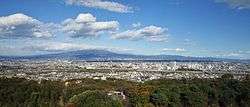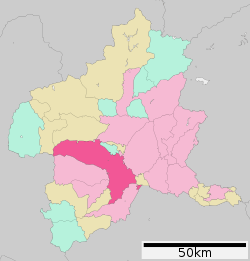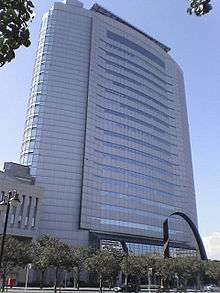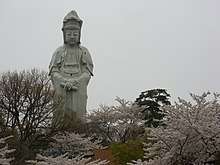Takasaki
Takasaki (高崎市, Takasaki-shi, [takasakiɕi]) is a city located in Gunma Prefecture, Japan. As of October 1, 2019, the city had an estimated population of 368,667, and a population density of 803 persons per km². Its total area is 459.16 square kilometres (177.28 sq mi). Takasaki is famous as the hometown of the Daruma doll, theoretically representing the Buddhist sage Bodhidharma and in modern practice a symbol of good luck.
Takasaki 高崎市 | |
|---|---|
 City view from Takasaki Kannon | |
 Flag  Seal | |
 Location of Takasaki in Gunma Prefecture | |
 Takasaki | |
| Coordinates: 36°19′18.8″N 139°0′11.8″E | |
| Country | Japan |
| Region | Kantō |
| Prefecture | Gunma Prefecture |
| Government | |
| • Mayor | Kenji Tomioka (since May 2011) |
| Area | |
| • Total | 459.16 km2 (177.28 sq mi) |
| Population (October 1, 2019) | |
| • Total | 368,667 |
| • Density | 800/km2 (2,100/sq mi) |
| Time zone | UTC+9 (Japan Standard Time) |
| Symbols | |
| • Tree | Zelkova serrata, Cyclobalanopsis |
| • Flower | Sakura |
| • Bird | Japanese bush-warbler |
| Phone number | 027-321-111 |
| Address | Takamatsu-cho 35-1, Takasaki-shi, Gunma-ken 370-8501 |
| Website | www.city.takasaki.gunma.jp |


History
During the Edo period, the area of present-day Takasaki was the center of the Takasaki Domain, a feudal domain held by a branch of the Matsudaira clan under the Tokugawa shogunate in Kōzuke Province. The area also prospered from its location on the Nakasendō highway connecting Edo with Kyoto. Post stations located within the borders of modern Takasaki were: Shinmachi-shuku, Kuragano-shuku, and Takasaki-shuku. Following the Meiji Restoration, Takasaki was briefly capital of Gunma Prefecture, before the capital was moved to Maebashi in 1881.
Takasaki Town was created within Gunma District, Gunma on April 1, 1889 with the creation of the municipalities system. It was raised to city status on April 1, 1900. On April 1, 1927, Takasaki annexed the neighboring villages of Tsukasawa and Kataoka, followed by Sano on October 1, 1937. The city largely escaped damage in World War II. Following the war, it continued to expand its borders by annexing the village of Rokugo on April 1, 1951, Shintakao and Nakamura as well as Yawata and Toyooka from Ushi District on January 20, 1955. This was followed by Orui village and Sano village from Tano District on September 30, 1956. The city celebrated its 360th anniversary in 1963 and annexed the town of Kuragano on March 31 of the same year. On September 1, 1965 the village of Gunnan was annexed.
In September 1987, five-year-old Yoshiaki Ogiwara, the son of a local firefighter, was abducted and subsequently murdered in Takasaki. The murder received heavy media coverage across Japan.[1]
On April 1, 2001 Takasaki was proclaimed a Special City (Tokurei-shi), which gave it greater autonomy.
On January 23, 2006, the towns of Gunma, Kurabuchi and Misato (all from Gunma District), and the town of Shinmachi (from Tano District) were merged into Takasaki. On October 1, 2006, the town of Haruna (from Gunma District) was merged into Takasaki. Gunma District was dissolved as a result of this merger. On June 1, 2009, the town of Yoshii (from Tano District) was merged into Takasaki.[2]
Takasaki was elevated to a Core city with even greater autonomy on April 1, 2011.
Geography
Takasaki is located in the southwestern part of Gunma Prefecture in the flat northern part of the Kantō Plain.
Surrounding municipalities
Economy
Takasaki is a regional commercial center and transportation hub, and is a major industrial center within Gunma Prefecture. Companies headquartered in Takasaki include:
- CUSCO Japan – automotive parts
- Yamada Denki – home appliance retailer
Education
There are 9 public and 5 private high schools, 25 middle schools, and 60 elementary schools in Takasaki.
Universities and colleges
- Takasaki City University of Economics
- Takasaki University of Commerce
- Takasaki University of Health and Welfare
- Gumma Paz College
- Jobu University
- Ikuei Junior College
- Takasaki University of Health and Welfare Junior College
- Takasaki University of Commerce Junior College
- Niijima Gakuen Junior College
Primary and secondary education
- Takasaki has sixty elementary schools, 25 middle schools and nine public and five private high schools. In addition, there are also five special education schools.
Transportation
Railway
The city of Takasaki is served by the following JR East lines:
- Jōetsu Shinkansen, Hokuriku Shinkansen
- Takasaki Line, Shōnan-Shinjuku Line, Ueno-Tokyo Line
- Jōetsu Line
- Shinetsu Main Line
Highway
.png)
.png)
.png)





Local attractions
- Takasaki Castle
- Mount Haruna
- Lake Haruna
- Haruna Shrine
- Minowa Castle
- The Museum of Modern Art, Gunma
- The sound of a suikinkutsu in the Suikintei Garden of former Yoshii town is designated as one of the 100 Soundscapes of Japan by the Ministry of the Environment [3]
Sport
- Arte Takasaki - football (soccer) club
Twin towns – sister cities




Notable people
- Toll Yagami, musician (Buck-Tick)
- Yutaka Higuchi, musician (Buck-Tick)
- Takeo Fukuda, former Prime Minister of Japan
- Yasuo Fukuda, former Prime Minister of Japan
- Kyosuke Himuro, musician (Boøwy)
- Tomoyasu Hotei, musician (Boøwy)
- Fujio Masuoka, inventor of flash memory
- Kanai Mieko (born in Takasaki 1947), writer
- Hirofumi Nakasone, politician
- Yasuhiro Nakasone, former Prime Minister of Japan
- Kiyoshi Ogawa, Imperial Japanese Navy kamikaze pilot
- Hakubun Shimomura, politician
- German architect Bruno Taut lived for some time in Takasaki
- Kenji Tsukagoshi, navigator and aviator
References
- Kristof, Nicholas D. "Kidnap-murder of 5-year-old shakes Japan," The New York Times, 20 September 1987. Retrieved 12 April 2015.
- Information at kokudo.or.jp Archived August 21, 2006, at the Wayback Machine
- "100 Soundscapes of Japan". Ministry of the Environment. Retrieved 8 December 2015.
- "友好都市". city.takasaki.gunma.jp (in Japanese). Takasaki. Retrieved 2020-04-08.
External links
| Wikimedia Commons has media related to Takasaki, Gunma. |
- Official Website (in Japanese)